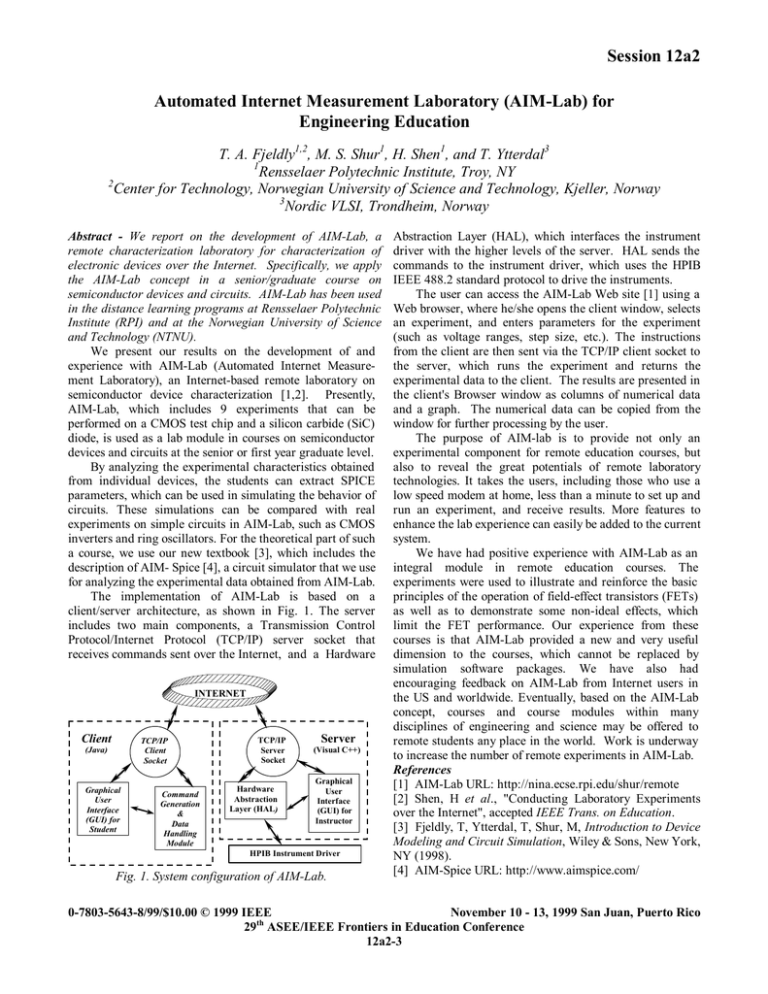(AIM-Lab) for Engineering Education
advertisement

Session 12a2 Automated Internet Measurement Laboratory (AIM-Lab) for Engineering Education T. A. Fjeldly1,2, M. S. Shur1, H. Shen1, and T. Ytterdal3 1 Rensselaer Polytechnic Institute, Troy, NY 2 Center for Technology, Norwegian University of Science and Technology, Kjeller, Norway 3 Nordic VLSI, Trondheim, Norway Abstract - We report on the development of AIM-Lab, a remote characterization laboratory for characterization of electronic devices over the Internet. Specifically, we apply the AIM-Lab concept in a senior/graduate course on semiconductor devices and circuits. AIM-Lab has been used in the distance learning programs at Rensselaer Polytechnic Institute (RPI) and at the Norwegian University of Science and Technology (NTNU). We present our results on the development of and experience with AIM-Lab (Automated Internet Measurement Laboratory), an Internet-based remote laboratory on semiconductor device characterization [1,2]. Presently, AIM-Lab, which includes 9 experiments that can be performed on a CMOS test chip and a silicon carbide (SiC) diode, is used as a lab module in courses on semiconductor devices and circuits at the senior or first year graduate level. By analyzing the experimental characteristics obtained from individual devices, the students can extract SPICE parameters, which can be used in simulating the behavior of circuits. These simulations can be compared with real experiments on simple circuits in AIM-Lab, such as CMOS inverters and ring oscillators. For the theoretical part of such a course, we use our new textbook [3], which includes the description of AIM- Spice [4], a circuit simulator that we use for analyzing the experimental data obtained from AIM-Lab. The implementation of AIM-Lab is based on a client/server architecture, as shown in Fig. 1. The server includes two main components, a Transmission Control Protocol/Internet Protocol (TCP/IP) server socket that receives commands sent over the Internet, and a Hardware INTERNET Client TCP/IP Client Socket (Java) Graphical User Interface (GUI) for Student Command Generation & Data Handling Module TCP/IP Server Socket Hardware Abstraction Layer (HAL) Server (Visual C++) Graphical User Interface (GUI) for Instructor HPIB Instrument Driver Fig. 1. System configuration of AIM-Lab. Abstraction Layer (HAL), which interfaces the instrument driver with the higher levels of the server. HAL sends the commands to the instrument driver, which uses the HPIB IEEE 488.2 standard protocol to drive the instruments. The user can access the AIM-Lab Web site [1] using a Web browser, where he/she opens the client window, selects an experiment, and enters parameters for the experiment (such as voltage ranges, step size, etc.). The instructions from the client are then sent via the TCP/IP client socket to the server, which runs the experiment and returns the experimental data to the client. The results are presented in the client's Browser window as columns of numerical data and a graph. The numerical data can be copied from the window for further processing by the user. The purpose of AIM-lab is to provide not only an experimental component for remote education courses, but also to reveal the great potentials of remote laboratory technologies. It takes the users, including those who use a low speed modem at home, less than a minute to set up and run an experiment, and receive results. More features to enhance the lab experience can easily be added to the current system. We have had positive experience with AIM-Lab as an integral module in remote education courses. The experiments were used to illustrate and reinforce the basic principles of the operation of field-effect transistors (FETs) as well as to demonstrate some non-ideal effects, which limit the FET performance. Our experience from these courses is that AIM-Lab provided a new and very useful dimension to the courses, which cannot be replaced by simulation software packages. We have also had encouraging feedback on AIM-Lab from Internet users in the US and worldwide. Eventually, based on the AIM-Lab concept, courses and course modules within many disciplines of engineering and science may be offered to remote students any place in the world. Work is underway to increase the number of remote experiments in AIM-Lab. References [1] AIM-Lab URL: http://nina.ecse.rpi.edu/shur/remote [2] Shen, H et al., "Conducting Laboratory Experiments over the Internet", accepted IEEE Trans. on Education. [3] Fjeldly, T, Ytterdal, T, Shur, M, Introduction to Device Modeling and Circuit Simulation, Wiley & Sons, New York, NY (1998). [4] AIM-Spice URL: http://www.aimspice.com/ 0-7803-5643-8/99/$10.00 © 1999 IEEE November 10 - 13, 1999 San Juan, Puerto Rico 29th ASEE/IEEE Frontiers in Education Conference 12a2-3
